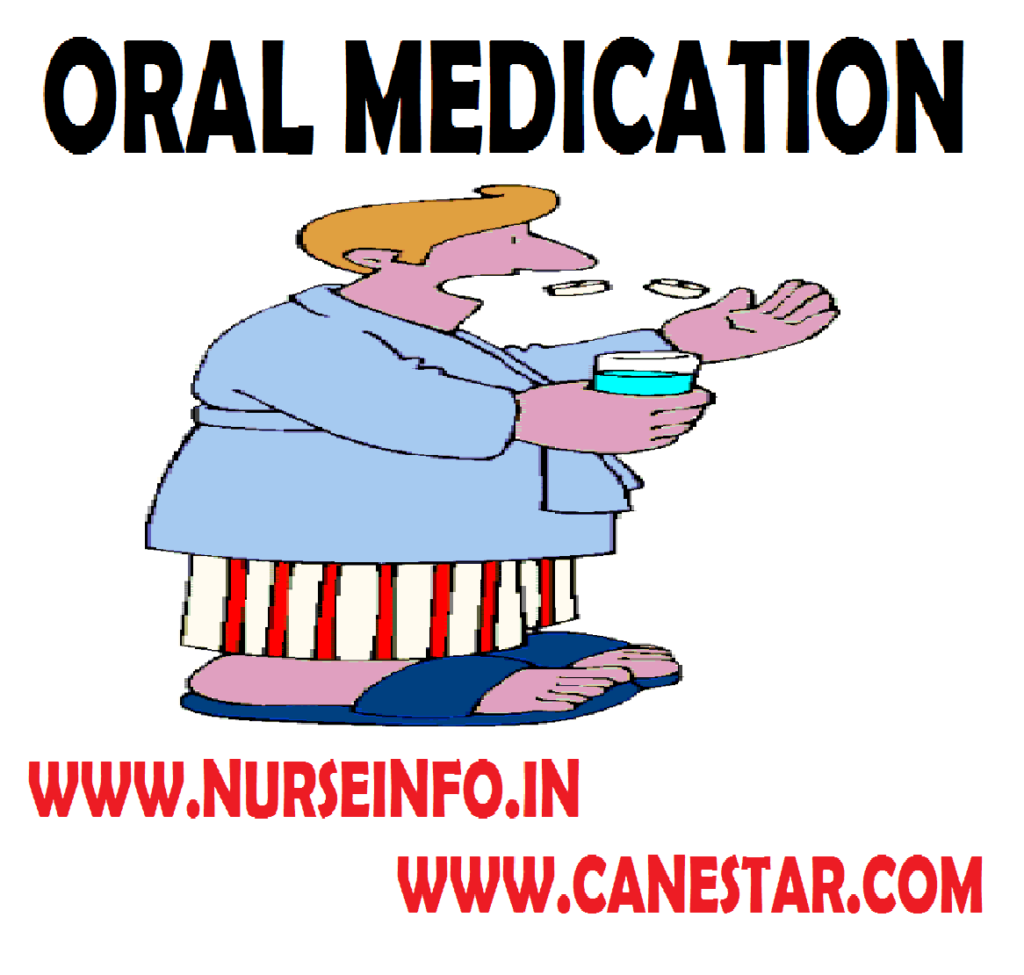ORAL MEDICATION
NURSING PROCEDURES LIST CLICK HERE
Oral medication are defined as the administration of medication by mouth and ensuring that patient swallows the medicine
Purpose
- To prevent the disease
- To cure the disease
- To promote the health
- To give palliative treatment
- To give as a symptomatic treatment
Nurses Responsibility in Administration of Oral Medication
- Check the diagnosis and age of the patient
- Check the purpose of medication
- Check the identification of the patient, the name and bed number
- Check the physician’s orders for the correct name of the drug, dosage and method of administration
- Check the nurse record for the time at which the last dose was given
- Check for any contraindications present in the patient for an oral intake of the medicines such as nausea, vomiting, unconsciousness etc
- Check the character of the drug – whether it can be taken safely by the oral method
- Check the form of the drug available and the correct method of administration
- Check the level of consciousness of the patient and ability to follow instructions
- Check the abilities and limitations in swallowing the medications
Equipment
A trolley containing
- A bowel of clean water
- Ounce glass, medicine glass, dropper teaspoon to measure the medicine
- Drinking water in a feeding cup
- Mortar and pestle to crush and powder the table if necessary
- Duster/towel to wipe the outside the bottle after pouring the medicine ordered
- Kidney tray and paper bag to discard the waste
- Medicine cards to write the medication order from patients order sheet
Preparation of the Patient
- Explain the procedure to the patient. Tell the advantages needs of medication
- If patient is allowed to sit assist him to sit
- Never give medication in flat position as there is a danger of aspiration of drug and fluid when swallowed.
- Give a mouth wash, if necessary
- If medication is ill tasting, prepare a drink to mask the taste of the medication
- Protect the bed clothes and garments with the towel placed under the chin across the chest
Procedure
- Keep the patient comfortable in bed
- Arrange the articles at the bed side
- Identify patient by name and check the name board at bed side
- Check the nurse’s record to find out when drug was last administered
- Check for special instructions and check vital signs if needed
- Select medicine from patient’s locker and check medication label thrice
- Encourage patient to sit-up and make sure medicines are swallowed
- First give little water to moisten the mouth and then give medicine one at a time
- Stay with the patient until the medicine has been swallowed; give him a drink of water after it
After Care of the Patient and Articles
- Remove the towel and wipe the face with it
- Position the patient for good body alignment
- Take all articles to the utility room. Wash and dry all articles and replace them in their proper place
- Wash hands
- Record medications given in medication sheet and also nurses record
- Record any reaction observed after the administration of the drug
- Report any reaction to the ward sister and doctor-in-charge
Contraindications
- Continuous vomiting
- Gastric or intestinal suction
- Unconscious patient
- Patient who are unable to swallow
- Patient on nil per oral
Advantages
- This method is safe and convenient
- It is effective method
- There is no pain while administering the drug
- Allergic reactions are very less
Disadvantages
- Sometimes the patient may not swallow the medicine
- The drug may only be partially observed
- It may irritate the gastric mucosa and can cause vomiting or diarrhea and the effect is lost


